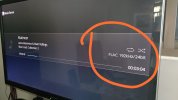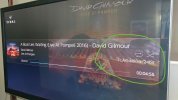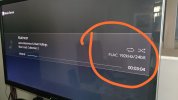This is a review and very detailed measurements of the Pioneer VSX-LX504 Home Theater Audio & Video Receiver (AVR). It came about when my trusty Pioneer Elite SC-61 started to produce a UE22 Error. A bit searching showed this is a TI DSP that goes bad causing audio to mute and eventually go dead completely. Despite being acquired by Onkyo, Pioneer made good for a while by sending replacement DSP board to owners. Alas, the replacements are all gone and now Pioneer only offers a trade in. After filling out paperwork and such, they offered me a VSX-LX504 for around US $540 or so. I see it listed on Amazon for US $899 with a list price of US $999. The unit arrived yesterday and I was anxious to put it on the bench and see how it performs.
From the outside, you would think nothing is changed in Pioneer AVRs as it looks almost identical to my SC-61, with the exception of a lot more labels stuck to the front panel:
Same stiff and lousy feeling volume control adorns the unit on the right. Ditto for the source selector knob on the left. Neither imparts feeling of luxury or quality.
The back panel is the usual affair too with more connectors than you ever use:
The speaker terminals feel pretty cheap, wiggling with any movement of my banana jacks.
Who on earth needs analog component video in this day and age is beyond me. They should eliminate those and instead, give us a proper USB input to be used as a DAC.
We have a nice set of pre-out connectors which I used for testing the performance of its internal DAC (and processing). No multi-channel analog input is provided for people who want to feed it SACD and such from days long gone.

I did not mess with much on the unit other than configuring it for 2-channel output and testing Direct and Pure Direct mode:
Strangely, every time I let go of the button to put it in Pure Direct, it would change to Autosurround or some such nonsense. Fortunately seemed to work in Pure Direct regardless.
The user interface is much improved over the primitive one in my SC-61. There is however a 3 to 4 second delay before the menus come up. Why? This should be instant.
Compatibility with my PC's Nvidia was horrific with resolution all over the place on my BenQ 4K monitor with colors washed out and seemingly wrong. I suspect the latter could be fixed with setting the mode to video range rather than "PC" but I wish the Pioneer would maintain that in pass-through mode. I did not reboot however so maybe that fixes things.
The unit itself is surprisingly light for something with 9 channels of amplification, rated at some 135 watts each. The heatsinks are beefier than other lower priced AVRs we have tested but they are very short. A rather large 5 ot 6 inch fan sits on top of them which never came on during my testing. The unit seemed to operated pretty cool despite using traditional amplification. Likely uses class G voltage switching to keep efficiency higher, and heat dissipation low.
There is a lot of data coming your way so buckle up and lets get through it!
S/PDIF DAC Audio Measurements
For ease of testing I stated by using the S/PDIF coax input. Later I will show HDMI performance as well for a couple of tests. Here is the DAC performance in VSX-LX504 using coax input and pre-out with the speaker cables connected to my dummy load:
View attachment 32590
Yuck. What a disaster. We have tons of distortion and noise product. Output level is just 1.6 volt instead of 2 at 0 dB on the volume control. Remembering that the amplifier clips in some of these products and then destroys the fidelity of the power to the DAC, I disconnected the speaker wires and measured again:
View attachment 32591
OK, that is much better. I turned up the volume to 2.5 dB I think and got 2 volts. SINAD (signal relative to noise and distortion) did not improve hardly at all. So 97 dB is it:
View attachment 32592
Above, I have highlighted the VSX-LX504 which landed in third tier in orange and the previously r
eviewed Pioneer VSX-LX303. I don't recall if the LX303 also could have benefited from not using its speaker terminal. Either way, this is "OK" performance but of course beaten by a number of DACs some of which retail as low as $70. And the Apple dongle at just $9.
Above were in Direct mode. Switching to Pure direct didn't make much difference in SINAD:
View attachment 32594
But does clean up the spectrum of the FFT substantially, leaving us just the harmonic distortion spikes.
Signal to noise ratio is decent:
View attachment 32593
Jitter performance was rather ugly:
View attachment 32596
Clearly there are many sources of interference in the output of the front left and right DACs which I tested in this review. Fortunately not an audible concern.
Intermodulation distortion follows the lead of THD+N:
View attachment 32597
As noted earlier, Pure Direct doesn't help much here either.
Linearity is good until we get to the limit at -120 dB:
View attachment 32598
S/PDIF doesn't support 192 kHz so I had to settle for my 7-tone test:
View attachment 32599
We have about 100 to 110 dB of distortion free range so better than 16 bits but not 20 bits which we can get with music-centric high-performance DACs.
Reconstruction filter is the typical one that balances attenuation with slower than required roll off:
View attachment 32600
This hurts the wideband THD+N versus frequency due to aliasing components sneaking out in ultrasonics:
View attachment 32601
View attachment 32602
The filter needs to have higher attenuation to kill that 47 and 49 kHz spikes in order to improve the previous test. Fortunately these tones are not audible so not a real concern.
HDMI Audio Measurements
I used Roon to play my reference 1 kHz, 24-bit signal in exclusive WASAPI mode to measure the dashboard performance using HDMI input and pre-out:
View attachment 32603
SINAD drops 1 or 2 dB likely due to higher noise floor (harmonics are below 100 dB).
Jitter performance remained more or less the same:
View attachment 32604
Overall, HDMI input seems to impart a small penalty over S/PDIF input.
Amplifier Audio Measurements
This test turned out to be a lot more of a pain than would be otherwise if the unit was well designed and documented. Let me show you how with frequency response test:
View attachment 32605
As you see, in Direct mode, the input is seemingly digitized using a low sample rate of 44.1 kHz or 48 kHz. I suspect this is due to ability then to provide equalization and other digital processing to this analog input.
Switching the unit to Pure Direct mode allowed the full bandwidth of the unit to shine, extending to 100 kHz and beyond. Note that I did not equalize the levels in the above graph so don't mind them being at different reference value to 0 dB.
Switching to S/PDIF input, shows the same discrepancy:
View attachment 32606
So it is pretty clear that internal processing is at just 48 kHz or so. Any dream you had of high-resolution audio is dashed if you use any of the equalization features! That high-res sticker on the front of the unit needs to be removed.
The resampler sure adds a not of noise and spurious tones as this dashboard view in Direct mode shows with digital input:
View attachment 32607
Switching to analog input gives us this:
View attachment 32609
Noise floor is higher but the spectrum is much cleaner showing the issues with the resampler as noted.
The spectrum of 1 kHz shows the difference between direct and pure direct modes:
View attachment 32610
With all effects turned off, there should not be this kind of difference.
We see the same in signal to noise ratio in both modes:
View attachment 32611
Power output versus load at 4 ohm was initially shocking at just 33 watts!
View attachment 32612
Then I remembered the problem with VSX-LX303 where it would severely limit power when warm. So I power cycled the unit and got the much higher 204 watts of power. Same thing happened using 8 ohm load:
View attachment 32613
I measured how long it took for this to happen at different power levels:
View attachment 32614
View attachment 32615
What is odd here is that the amplifier did not feel warm at all, nor did the fan come on. Seems to be some kind of timer that counts how long power is needed above the low power supply rail and clicks into this low output power mode. VW dieselgate anyone?
I forced the same thing to happen with a 50% duty cycle sine wave burst:
View attachment 32618
Burst power was quite high in both impedances:
View attachment 32619
View attachment 32620
Conclusions
5+ years have gone by since I had my Pioneer SC-61. Sadly, there doesn't seem to be much progress here. If anything, we seem to have taken a step back with Pioneer AVR line. Even in a "$1000" AVR, there is that power pull back with no documentation whatsoever. Also disappointing is that the internal processing is stuck at 48 kHz. I would have wanted to at least see 96 kHz there. Surely DSP power is that much cheaper than it used to be. I know, they have to spread that out to 9 channels so the budget per channel can't be increased. Sigh. As a minimum, companies need to document such things.
I returned the Pioneer VSX-LX303 to Amazon. No such luck here because these trade-ins are not reversible so I will be putting this unit in my living room.

Needless to say, I can't recommend Pioneer line of AVRs. Hoping other brands don't have such restrictions.
------------
As always, questions, comments, recommendations, etc. are welcome.
I am going to hold a funeral for my older Pioneer SC-61 AVR. Everyone is invited as long as you first
donate generously to the forum:
https://www.audiosciencereview.com/forum/index.php?threads/how-to-support-audio-science-review.8150/



